Guoxin Zhang
FGU3R: Fine-Grained Fusion via Unified 3D Representation for Multimodal 3D Object Detection
Jan 08, 2025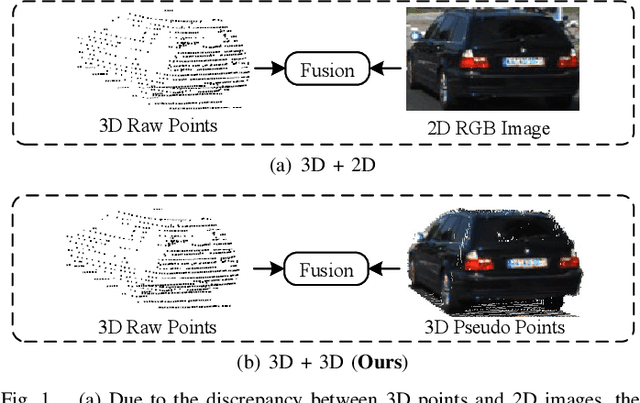
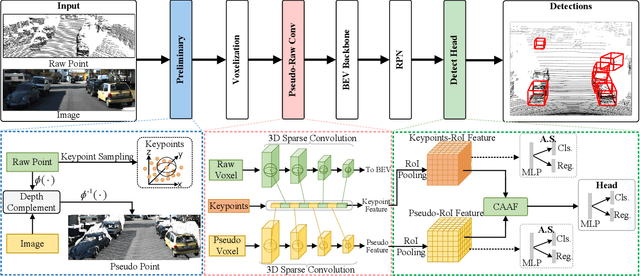


Abstract:Multimodal 3D object detection has garnered considerable interest in autonomous driving. However, multimodal detectors suffer from dimension mismatches that derive from fusing 3D points with 2D pixels coarsely, which leads to sub-optimal fusion performance. In this paper, we propose a multimodal framework FGU3R to tackle the issue mentioned above via unified 3D representation and fine-grained fusion, which consists of two important components. First, we propose an efficient feature extractor for raw and pseudo points, termed Pseudo-Raw Convolution (PRConv), which modulates multimodal features synchronously and aggregates the features from different types of points on key points based on multimodal interaction. Second, a Cross-Attention Adaptive Fusion (CAAF) is designed to fuse homogeneous 3D RoI (Region of Interest) features adaptively via a cross-attention variant in a fine-grained manner. Together they make fine-grained fusion on unified 3D representation. The experiments conducted on the KITTI and nuScenes show the effectiveness of our proposed method.
Segmentation-aware Prior Assisted Joint Global Information Aggregated 3D Building Reconstruction
Oct 24, 2024Abstract:Multi-View Stereo plays a pivotal role in civil engineering by facilitating 3D modeling, precise engineering surveying, quantitative analysis, as well as monitoring and maintenance. It serves as a valuable tool, offering high-precision and real-time spatial information crucial for various engineering projects. However, Multi-View Stereo algorithms encounter challenges in reconstructing weakly-textured regions within large-scale building scenes. In these areas, the stereo matching of pixels often fails, leading to inaccurate depth estimations. Based on the Segment Anything Model and RANSAC algorithm, we propose an algorithm that accurately segments weakly-textured regions and constructs their plane priors. These plane priors, combined with triangulation priors, form a reliable prior candidate set. Additionally, we introduce a novel global information aggregation cost function. This function selects optimal plane prior information based on global information in the prior candidate set, constrained by geometric consistency during the depth estimation update process. Experimental results on both the ETH3D benchmark dataset, aerial dataset, building dataset and real scenarios substantiate the superior performance of our method in producing 3D building models compared to other state-of-the-art methods. In summary, our work aims to enhance the completeness and density of 3D building reconstruction, carrying implications for broader applications in urban planning and virtual reality.
ContrastAlign: Toward Robust BEV Feature Alignment via Contrastive Learning for Multi-Modal 3D Object Detection
May 27, 2024



Abstract:In the field of 3D object detection tasks, fusing heterogeneous features from LiDAR and camera sensors into a unified Bird's Eye View (BEV) representation is a widely adopted paradigm. However, existing methods are often compromised by imprecise sensor calibration, resulting in feature misalignment in LiDAR-camera BEV fusion. Moreover, such inaccuracies result in errors in depth estimation for the camera branch, ultimately causing misalignment between LiDAR and camera BEV features. In this work, we propose a novel ContrastAlign approach that utilizes contrastive learning to enhance the alignment of heterogeneous modalities, thereby improving the robustness of the fusion process. Specifically, our approach includes the L-Instance module, which directly outputs LiDAR instance features within LiDAR BEV features. Then, we introduce the C-Instance module, which predicts camera instance features through RoI (Region of Interest) pooling on the camera BEV features. We propose the InstanceFusion module, which utilizes contrastive learning to generate similar instance features across heterogeneous modalities. We then use graph matching to calculate the similarity between the neighboring camera instance features and the similarity instance features to complete the alignment of instance features. Our method achieves state-of-the-art performance, with an mAP of 70.3%, surpassing BEVFusion by 1.8% on the nuScenes validation set. Importantly, our method outperforms BEVFusion by 7.3% under conditions with misalignment noise.
Robustness-Aware 3D Object Detection in Autonomous Driving: A Review and Outlook
Jan 12, 2024Abstract:In the realm of modern autonomous driving, the perception system is indispensable for accurately assessing the state of the surrounding environment, thereby enabling informed prediction and planning. Key to this system is 3D object detection methods, that utilize vehicle-mounted sensors such as LiDAR and cameras to identify the size, category, and location of nearby objects. Despite the surge in 3D object detection methods aimed at enhancing detection precision and efficiency, there is a gap in the literature that systematically examines their resilience against environmental variations, noise, and weather changes. This study emphasizes the importance of robustness, alongside accuracy and latency, in evaluating perception systems under practical scenarios. Our work presents an extensive survey of camera-based, LiDAR-based, and multimodal 3D object detection algorithms, thoroughly evaluating their trade-off between accuracy, latency, and robustness, particularly on datasets like KITTI-C and nuScenes-C to ensure fair comparisons. Among these,multimodal 3D detection approaches exhibit superior robustness and a novel taxonomy is introduced to reorganize its literature for enhanced clarity. This survey aims to offer a more practical perspective on the current capabilities and constraints of 3D object detection algorithms in real-world applications, thus steering future research towards robustness-centric advancements
VoxelNextFusion: A Simple, Unified and Effective Voxel Fusion Framework for Multi-Modal 3D Object Detection
Jan 05, 2024Abstract:LiDAR-camera fusion can enhance the performance of 3D object detection by utilizing complementary information between depth-aware LiDAR points and semantically rich images. Existing voxel-based methods face significant challenges when fusing sparse voxel features with dense image features in a one-to-one manner, resulting in the loss of the advantages of images, including semantic and continuity information, leading to sub-optimal detection performance, especially at long distances. In this paper, we present VoxelNextFusion, a multi-modal 3D object detection framework specifically designed for voxel-based methods, which effectively bridges the gap between sparse point clouds and dense images. In particular, we propose a voxel-based image pipeline that involves projecting point clouds onto images to obtain both pixel- and patch-level features. These features are then fused using a self-attention to obtain a combined representation. Moreover, to address the issue of background features present in patches, we propose a feature importance module that effectively distinguishes between foreground and background features, thus minimizing the impact of the background features. Extensive experiments were conducted on the widely used KITTI and nuScenes 3D object detection benchmarks. Notably, our VoxelNextFusion achieved around +3.20% in AP@0.7 improvement for car detection in hard level compared to the Voxel R-CNN baseline on the KITTI test dataset
ITTR: Unpaired Image-to-Image Translation with Transformers
Mar 30, 2022



Abstract:Unpaired image-to-image translation is to translate an image from a source domain to a target domain without paired training data. By utilizing CNN in extracting local semantics, various techniques have been developed to improve the translation performance. However, CNN-based generators lack the ability to capture long-range dependency to well exploit global semantics. Recently, Vision Transformers have been widely investigated for recognition tasks. Though appealing, it is inappropriate to simply transfer a recognition-based vision transformer to image-to-image translation due to the generation difficulty and the computation limitation. In this paper, we propose an effective and efficient architecture for unpaired Image-to-Image Translation with Transformers (ITTR). It has two main designs: 1) hybrid perception block (HPB) for token mixing from different receptive fields to utilize global semantics; 2) dual pruned self-attention (DPSA) to sharply reduce the computational complexity. Our ITTR outperforms the state-of-the-arts for unpaired image-to-image translation on six benchmark datasets.
Audio-Driven Talking Face Video Generation with Dynamic Convolution Kernels
Jan 16, 2022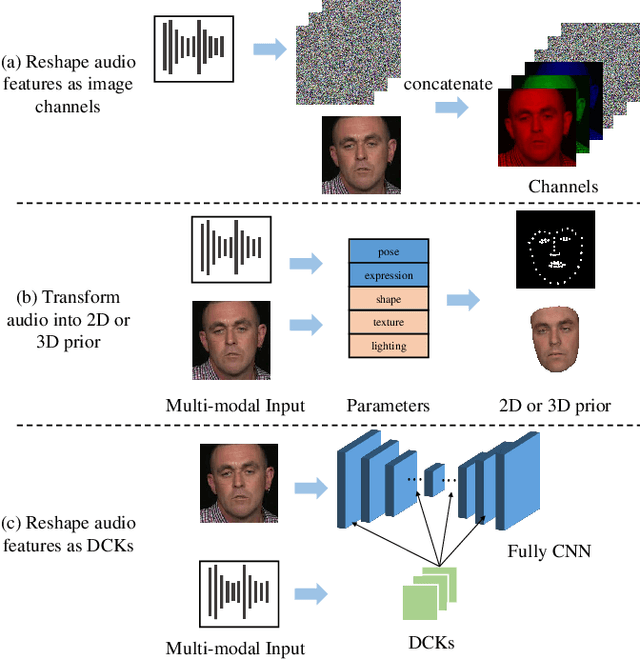
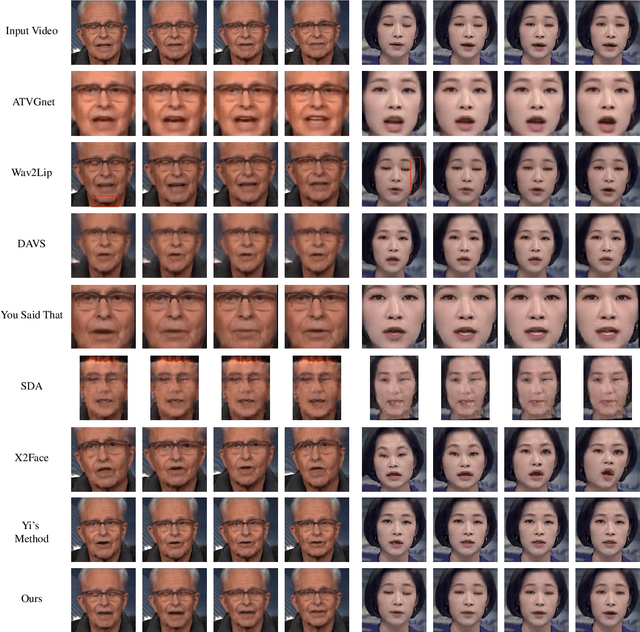
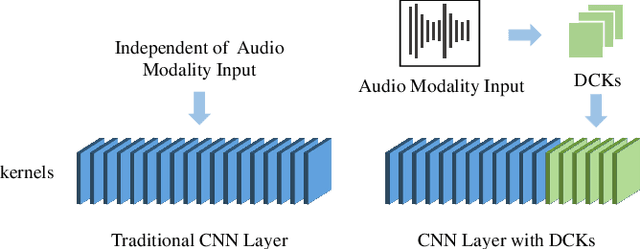

Abstract:In this paper, we present a dynamic convolution kernel (DCK) strategy for convolutional neural networks. Using a fully convolutional network with the proposed DCKs, high-quality talking-face video can be generated from multi-modal sources (i.e., unmatched audio and video) in real time, and our trained model is robust to different identities, head postures, and input audios. Our proposed DCKs are specially designed for audio-driven talking face video generation, leading to a simple yet effective end-to-end system. We also provide a theoretical analysis to interpret why DCKs work. Experimental results show that our method can generate high-quality talking-face video with background at 60 fps. Comparison and evaluation between our method and the state-of-the-art methods demonstrate the superiority of our method.
BlendGAN: Implicitly GAN Blending for Arbitrary Stylized Face Generation
Oct 22, 2021



Abstract:Generative Adversarial Networks (GANs) have made a dramatic leap in high-fidelity image synthesis and stylized face generation. Recently, a layer-swapping mechanism has been developed to improve the stylization performance. However, this method is incapable of fitting arbitrary styles in a single model and requires hundreds of style-consistent training images for each style. To address the above issues, we propose BlendGAN for arbitrary stylized face generation by leveraging a flexible blending strategy and a generic artistic dataset. Specifically, we first train a self-supervised style encoder on the generic artistic dataset to extract the representations of arbitrary styles. In addition, a weighted blending module (WBM) is proposed to blend face and style representations implicitly and control the arbitrary stylization effect. By doing so, BlendGAN can gracefully fit arbitrary styles in a unified model while avoiding case-by-case preparation of style-consistent training images. To this end, we also present a novel large-scale artistic face dataset AAHQ. Extensive experiments demonstrate that BlendGAN outperforms state-of-the-art methods in terms of visual quality and style diversity for both latent-guided and reference-guided stylized face synthesis.
Exploring Set Similarity for Dense Self-supervised Representation Learning
Jul 19, 2021



Abstract:By considering the spatial correspondence, dense self-supervised representation learning has achieved superior performance on various dense prediction tasks. However, the pixel-level correspondence tends to be noisy because of many similar misleading pixels, e.g., backgrounds. To address this issue, in this paper, we propose to explore \textbf{set} \textbf{sim}ilarity (SetSim) for dense self-supervised representation learning. We generalize pixel-wise similarity learning to set-wise one to improve the robustness because sets contain more semantic and structure information. Specifically, by resorting to attentional features of views, we establish corresponding sets, thus filtering out noisy backgrounds that may cause incorrect correspondences. Meanwhile, these attentional features can keep the coherence of the same image across different views to alleviate semantic inconsistency. We further search the cross-view nearest neighbours of sets and employ the structured neighbourhood information to enhance the robustness. Empirical evaluations demonstrate that SetSim is superior to state-of-the-art methods on object detection, keypoint detection, instance segmentation, and semantic segmentation.
 Add to Chrome
Add to Chrome Add to Firefox
Add to Firefox Add to Edge
Add to Edge